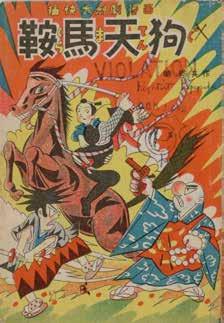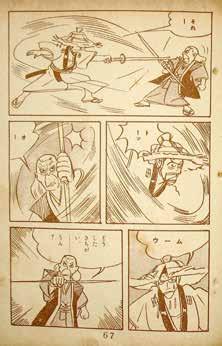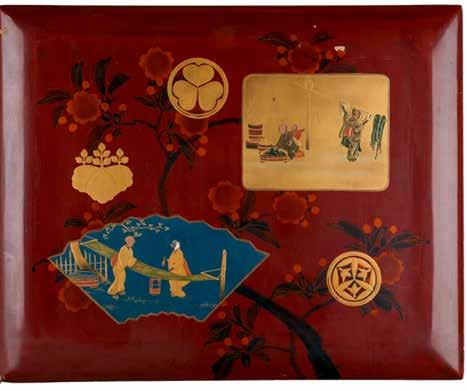
13 minute read
Rearmed and dismembered: the samurai in post-war visual culture
Ryan Holmberg
After the Second World War, the samurai, like his country, found himself disarmed. With the fall of the Japanese empire and the commencement of the Allied Occupation of Japan in August 1945, moves were made to dismantle the militarist and ‘feudal’ values that had underpinned Japanese society, in favour of democratic reforms that promised individual freedom and pacifism.
Advertisement
Passages in school textbooks that praised self-sacrifice unto death, unquestioned loyalty to one’s male seniors and the moral superiority of the Emperor’s subjects – a modernised samurai ethic – were blacked out in ink until revised editions were issued. Likewise, images of not only samurai, but traditional swashbuckling characters in general, were largely banned from visual culture. The Gordon W. Prange Collection at the University of Maryland, amassed by the Occupation’s Civil Censorship Detachment, contains numerous examples of manga (Japanese comics) featuring samurai, ninja and Edo-era police and thieves wielding blades and slicing through bodies, in which offending images are marked with ‘X’ in wax crayon, and words like ‘VIOLATION’, ‘DISAPPROVED’, or ‘RIGHTIST PROPAGANDA’ are written and stamped on their covers (fig. 1).
With the relaxation of press codes and the partial reacceptance of Japan’s military past as part of the nation’s repositioning as a bulwark against perceived communist threats from China and the Soviet Union, the samurai made a roaring comeback in the 1950s, although infused with a new, more naturalistic and contradictory ‘humanity’. Released in 1950, Kurosawa Akira’s (1910–1998) Rashomon, about a cowardly bandit who kills a hapless samurai and assaults his female companion, not only won a Golden Lion at the Venice Film Festival in 1951, it also established the growling, leaping Mifune Toshirō as the paradigm of the charismatic, if crazed, Japanese swordsman in the international imagination for years to come. Seven samurai (1954) cemented Kurosawa’s reputation as the premier auteur of samurai films that were both scintillating and philosophical, offering brash cinematic action, subtle characters and philosophical meditations on military virtue and violence.
Children’s comics and adjacent forms such as illustrated fiction, on the other hand, still largely worked with older models. They used the bouncy cartoony forms of pre-war manga to make slapstick-driven samurai adventures, or the naturalistic styles of pre-war magazine illustration to create emonogatari (picture stories, with equal parts image and text), starring coiffed and hooded, blade-wielding heroes solving mysteries and subduing bad guys.
fig. 1: TŌge Teppei, Kurama Tengu (Tateyama shobō, Osaka, 1948), cover. Gordon W. Prange Collection, University of Maryland Libraries
Things began to change with the expansive stories, humanistic messaging and cinematic panelling of Tezuka Osamu (1928–1989) in the late 1940s. Although best known for science fiction and adventure tales like Astroboy (Tetsuwan atomu, 1952–68) and Kimba the white lion (Janguru taitei, 1950–54), Tezuka also created samurai titles such as Cartoon Taiheiki (Manga Heigen Taiheiki, 1950), based on the classic epic about a power struggle between competing court families in the fourteenth century and their warrior retainers, and Tange Sazen (1954), about a fictional one-eyed, one-armed rōnin (masterless, wandering samurai), a character who had been popular in novels and movies since the 1920s. Boys’ manga magazines, as they grew into one of the main vehicles of baby boomer entertainment over the course of the 1950s, were filled with fast-paced, big-action period fiction and featured more samurai and ninja than perhaps any other type of character.
Then, in the mid-1950s, a new genre of comics emerged: gekiga (literally, dramatic pictures), which revolutionised, first, comics and then swathes of Japanese culture. Although gekiga’s focus on creating suspense through carefully cadenced cinematic panelling was initially designed for contemporary mystery settings, it was effectively applied to standoffs between swordsmen in desolate windswept fields, as well as to short-tempered samurai passing one another in the street. Where action was once typically depicted panoramically, now it was syncopated across panels of blades gleaming in the sun, brows sweating, eyes staring, speed lines cutting through the air, blood spurting and limbs falling. Coldblooded killers and Kurosawa-esque samurai, whose military values are compromised by life’s necessities, also began to feature more prominently. Saitō Takao (born 1936), for example, otherwise famed for the James Bond-like Golgo 13 (1968–present), was an avowed Kurosawa fan, who, from the mid-1950s, regularly published popular gekiga titles combining high action and brash heroes (fig. 2). His Muyōnosuke (1967–70), about a one-eyed samurai bounty hunter, was popular enough to be made into a live-action TV show.
Although a central genre in mainstream manga by the late 1960s, gekiga initially thrived as subculture on the ‘rental book’ kashihon market, where working class children could borrow books for a small sum per night and in which artists were allowed a greater freedom of artistic and political expression. Hirata Hiroshi (born 1937) led the way in the samurai genre. His naturalistic, yet dynamic, drawing style derived not from postwar cartoonists like Tezuka, but rather from a lineage of illustrated fiction dating back to print-designer Tsukioka Yoshitoshi in the late nineteenth century.
In contrast to the stereotyped killers and heroes of most other manga, Hirata often explored the lives of low-class samurai and the feelings of frustration and resentment they experienced while subject to the terrors of their superiors and the humiliations of poverty. Although with a strong fan base and praised in later years by luminaries like the novelist Mishima Yukio and Akira’s Ōtomo Katsuhiro, Hirata sometimes ran afoul of the wider public. His All falls: a tale of revenge (Fukushū: tsunde wa kuzushi, 1961) was singled out by parent and teacher groups as a case of gratuitous and corrupting violence in comics. His Bloody stumps samurai (Chidaruma

fig. 2: Saitō Takao, The dance of Asura (Hinomaru bunko, Osaka, 1956), interior page. Aomushi Shōwa Manga Library

fig. 3: Hirata Hiroshi, Bloody stumps samurai (Hinomaru bunko, Osaka, 1962), cover. Image courtesy Asakawa Mitsuhiro kenpō, 1962) (fig. 3), the tale of a young samurai of outcaste (buraku) descent who vows to avenge the wrongs against him and his people by the sword, even after he loses his arms and legs in gruesome combat, was attacked so aggressively by the Buraku Liberation League that the book was withdrawn from circulation and copies were burned.
Both books made quite an impression on Hirata’s peers, however. Umezu Kazuo (born 1936), one of Japan’s most beloved horror manga authors, published a homage in the form of The demon of revenge (Fukushū kijin, 1967), the story of an armless samurai. Tezuka’s popular Dororo (1967–68), about a rōnin born limbless and without organs, was also probably influenced by Hirata’s frequently grotesque work.
Political-period manga of a more sensitive and systematic sort was pioneered by Shirato Sanpei (born 1932) – although you wouldn’t know it from his debut manga, The wintry swordsman (Kogarashi kenshi, 1957), a swashbuckling samurai tale in a mixed gekiga and Disney-like Tezuka style. Shirato was the son of the painter Okamoto Tōki, one of the leaders of the pre-war proletarian arts movement. This background is readily apparent, however, in Shirato’s The legend of Kagemaru (Ninja bugeichō, 1959–62), a seventeen-volume epic featuring armed peasants, armed monks, evil samurai lords, soul-searching rōnin and shapeshifting ninja working behind the scenes. Kagemaru was not only one of the most popular kashihon manga, it was also extensively written about by intellectuals, who interpreted its themes of class struggle and guerilla warfare in relationship to contemporary protests against the right-wing government and remilitarisation in Japan.
In 1964, Shirato co-founded the monthly magazine Garo. Although remembered primarily as a venue for avant-garde and subcultural experimentation, in its early years Garo was an activist children’s magazine with strong leftist commitments, voiced mainly through samurai and ninja comics. The magazine’s pillar serial, Shirato’s nearly 5800-page The legend of Kamuy (Kamui den, 1964–71), wove together the struggles of multiple oppressed peoples in Japan’s past – with tenant farmers and buraku outcastes at the fore – against rapacious samurai lords and greedy capitalist merchants (fig. 4).
Supplementing Shirato’s social realist epic in the pages of Garo were Mizuki Shigeru’s (1922–2015) short parodies of Miyamoto Musashi, the famed seventeenth-century rōnin and paragon of manly lone-wolf fortitude, and Tsuge Yoshiharu’s (born 1937) comical and sentimental tales about poor samurai scheming to make ends meet or milking their receding status privileges. Thereafter, samurai and ninja would not feature prominently in Garo’s pages, with the exception, in the early 1970s, of Hanawa Kazuichi’s (born 1947) gory S&M send-ups of pre-war samurai fiction.
While Mishima’s ritual suicide in the Tokyo offices of the SelfDefense Forces in 1970 is often thought of as a tragic, if absurd, setback to attempts to revive reactionary forms of samurai manhood in Japan, samurai gekiga only really came into its own in the 1970s, helping to fuel the explosion of manga magazines for ‘mature’ readers (meaning young to middle-aged men), with increasingly more sex to balance out the blood.

Some of the most popular and influential of these titles were collaborations between writer Koike Kazuo (1936–2019), who had previously worked with Saitō Takao on Muyōnosuke, and Kojima Goseki (1928–2000), one of the lead artists for Shirato’s Kamuy, who originally made his name in the early 1960s with samurai romances for female readers, diverging from the genre’s masculinist norms. Lone wolf and cub (Kozure ōkami, 1970–76), concerning a wandering samurai forced to care for his toddler son while hunting his wife’s murderers, and Samurai executioner (1972–76), about the moral and personal trials of the shogun’s official executioner, are among their most famous titles. The former was made into a popular series of pulpy movies, with the sexuality amplified – this at a time when a fair number of erotic ‘pink films’ were set in the past.
In the late 1970s, the doyen of samurai gekiga, Hirata, created his most famous work, The loyal warriors of Satsuma (Satsuma Gishiden, 1977–82), about a group of samurai from an oppressed domain in Kyushu summoned north to create mammoth flood control works for the shogun. Hirata’s historical detail and draughtsmanship are as impressive as ever, but the chauvinistic chest-beating has begun to show its age. Samurai and courtesan themes also featured in the burgeoning genre of ‘ero-gekiga’ for men.
Not only were samurai gekiga bestsellers in Japan, they were also among the earliest manga to be translated into English and exert an influence on American and European comics. Hirata features in the simply titled Manga (published by Metro Scope, c.1980–82), potentially the first anthology of Japanese comics in English.
The great American cartoonist Frank Miller’s (born 1957) love for samurai and ninja gekiga and movies began shaping his work early on, as evident in his Wolverine mini-series (1982) with Chris Claremont (born 1950) and his solo graphic novel Rōnin (1983–84), continuing in classics like Batman: the dark knight returns (1986). Kevin Eastman (born 1962) and Peter Laird’s (born 1954) Teenage mutant ninja turtles (begun in 1984), which was conceived as a parody of Miller’s Japanesque comics, with obvious homage to Rōnin, effectively translated the swelling samurai and ninja boom into a full-blown entertainment franchise. The Japanese–American artist, Stan Sakai (born 1953), commenced his own Musashi and Kurosawa-inspired series, Usagi Yojimbo, starring a rōnin rabbit, likewise in 1984. It is still ongoing. Netflix recently announced it will produce an animated version.
And then the translations began in earnest. In 1987, First Comics in Illinois began publishing English editions of Lone wolf and cub, with covers by Miller (fig. 5). Each issue sold well over 100,000 copies. Also in 1987, Eclipse Comics in California included Shirato’s The tales of Kamuy (Kamui gaiden, published as The legend of Kamui) as part of its pioneering manga line. It also published an original collaboration between Hirata and the writer Sharman DiVono, Samurai, son of death (1987), with extensive background material on the historical personages and events depicted.
By the 1990s, ninja and samurai feature in countless American comics, including Mark Moretti and Joe Quesada’s Ninjak and William Tucci’s Shi. Animated cartoons like Genndy Tartakovsky’s Samurai Jack (2001–03, 2017) – influenced by Lone wolf and cub, Miller’s Rōnin, Kurosawa’s films –
fig. 5: Kojima Goseki and Koike Kazuo, Lone wolf and cub no. 1 (First Comics, 1987), cover artwork by Frank Miller

fig. 6: Okazaki Takahashi, Afro samurai (Parco shuppan, Tokyo, 2009), cover and more recent comics by artists such as Paul Pope and Ronald Wimberly attest to how far the DNA of samurai and ninja manga have reached into American cartooning, not to mention the impact they have had on cartoonists across Europe and East Asia. The movie version of Kamimura Kazuo’s (1940–86) Lady Snowblood (Shurayuki hime, 1972–73), a manga series about a female assassin during the Meiji period, scripted by Koike of Lone wolf and cub fame, inspired Quentin Tarantino’s Kill Bill (2003).
Meanwhile in Japan, although no longer the dominant genre that it was in the 1970s, samurai manga continue to produce major hits, inspiring adaptations in animation and live-action movies. Among the best-known globally is Samura Hiroaki’s (born 1970) Blade of the immortal (Mugen no jūnin, 1993–2015), starring a cursed rōnin who must kill a thousand evil men to regain his mortality and banish the ‘bloodworms’ in his body, which enable him to seal gaping wounds and reattach severed limbs.
Others include Inoue Takehiko’s (born 1966) Vagabond (1998–present), a stylish, spacious, expressionistic retelling of the trials of Musashi, and Yamaguchi Takayuki’s (born 1966) Death frenzy (Shigurui, 2003–10), an extremely graphic adaptation of novelist Nanjō Norio’s retelling of a seventeenth-century death match at a Tokugawa daimyo’s court. Not only does Yamaguchi’s penchant for ultraviolence recall Hirata Hiroshi’s work, but Hirata (who once adapted the same Nanjō novel in the 1960s) also created the calligraphic titles for the manga series. There is not a convenience store in Japan that doesn’t carry Comic Ran (est. 1998), Saitō Pro’s (Saitō Takao’s studio) long-running samurai gekiga monthly, popular among white- and blue-collar men on their lunch breaks and commutes.
The future of the samurai, however, lies in diversification. Okazaki Takashi’s (born 1974) initially obscure Afro samurai (1998–2002) (fig. 6), about a black rōnin seeking to obtain the power of a magical headband and avenge the murder of his father, became a pop culture phenomenon after it had been adapted as an animated series (2007) and subsequently an animated movie (2009), with Samuel L. Jackson serving as producer and lead voice actor, and the RZA of Wu-Tang Clan overseeing the soundtracks. Video games and plans for a live action film followed. Higashimura Akiko’s (born 1975) Snowflower tiger (Yukibana no tora, 2015–20), constructed around the theory that the famed daimyo, Uesugi Kenshin, was actually a woman, is a rarity in the male-dominated field of samurai manga: a popular work by a female artist, originally serialised in a woman’s magazine, with a female samurai as its main protagonist.
Samurai themes have even witnessed a resurgence in the fine arts, with painters like Yamaguchi Akira (born 1969) and Tenmyouya Hisashi (born 1966) creating neoclassical nihonga paintings crossing Japanese art history, retro-futurism, yakuza machismo, and pop culture such as manga and anime. The bushido codes of a bygone Japanese masculinity may perish at last, but the image of the samurai could very well prove to be immortal.

Selected samurai comics in English
Hirata Hiroshi, Bloody stumps samurai, Retrofit/Big Planet Comics, 2019.
Hirata Hiroshi, Satsuma gishiden, 3 vols, Dark Horse, 2006–07.
Hirata Hiroshi & Sharman DiVono, Samurai, son of death, Eclipse Comics, 1987.
Inoue Takehiko, Vagabond, 12 vols, VIZ Media, 2008–15.
Kamimura Kazuo & Koike Kazuo, Lady Snowblood, 2 vols, Dark Horse, 2005–06.
Kojima Goseki & Koike Kazuo, Lone wolf and cub, omnibus, 12 vols, Dark Horse, 2013–16.
Kojima Goseki & Koike Kazuo, Samurai executioner, omnibus 4 vols, Dark Horse, 2014–15.
Miller, Frank, Rōnin, DC Comics, 2019.
Okazaki Takashi, Afro samurai, 2 vols, Tor/Seven Seas, 2008–09.
Samura Hiroaki, Blade of the immortal, omnibus 10 vols, Dark Horse, 2017–19.
Sakai, Stan, Usagi Yojimbo: the special edition, Fantagraphics, 2015.
Tezuka Osamu, Dororo, Vertical, 2012.
Tsuge Yoshiharu, The swamp, Drawn & Quarterly, 2020.
Watsuki Nobuhiro, Rurouni Kenshin, omnibus 9 vols, VIZ Media, 2017–19.
Wimberly, Ronald, Prince of cats, Image Comics, 2019.










